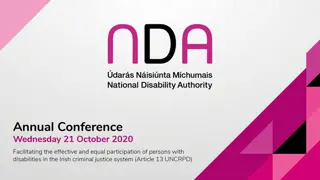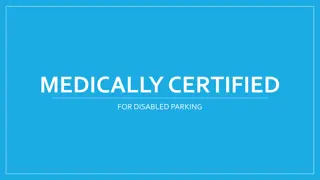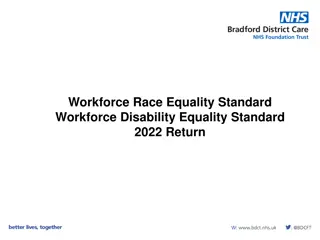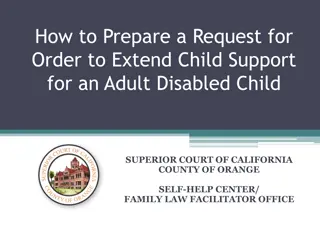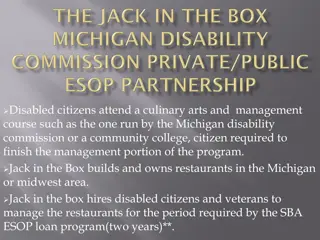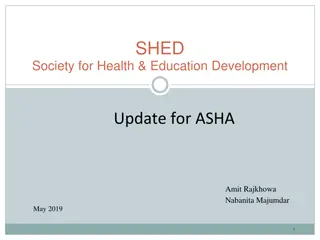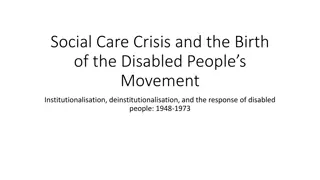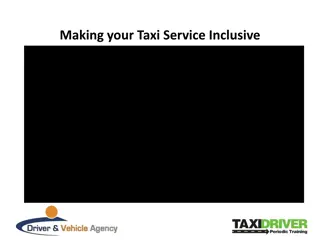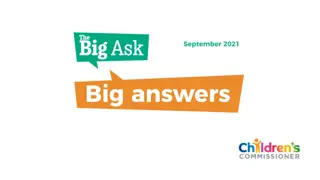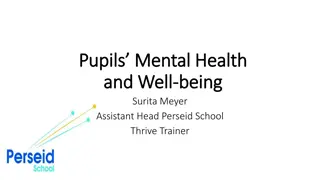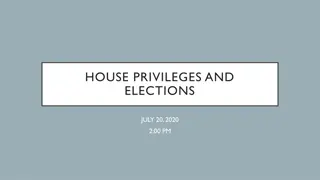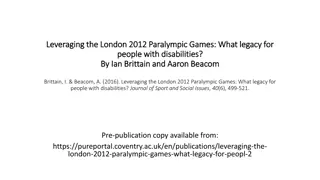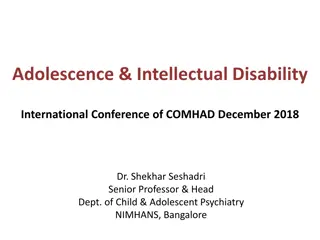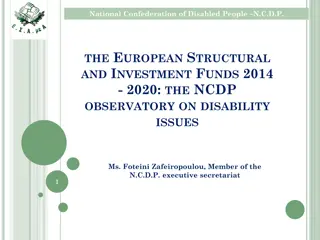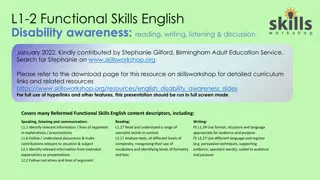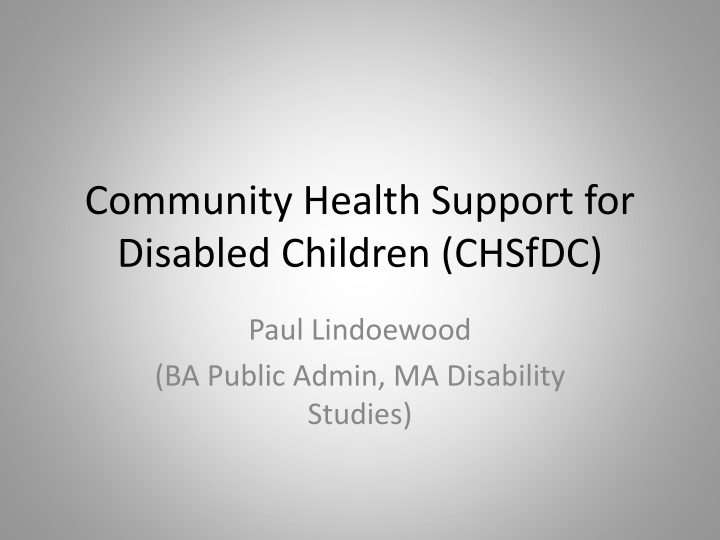
Supporting Disabled Children in Community Health Programs
Learn about the Community Health Support for Disabled Children (CHSfDC) project led by Paul Lindoewood, which aims to empower Community Health Workers to identify, support, and refer disabled children in various communities. Explore the project's targets, activities, and results, including training sessions for health workers and volunteers, as well as the coordination efforts with different organizations in the field of disability support. Discover how the project has reached and impacted disabled individuals across different age groups.
Uploaded on | 0 Views
Download Presentation

Please find below an Image/Link to download the presentation.
The content on the website is provided AS IS for your information and personal use only. It may not be sold, licensed, or shared on other websites without obtaining consent from the author. If you encounter any issues during the download, it is possible that the publisher has removed the file from their server.
You are allowed to download the files provided on this website for personal or commercial use, subject to the condition that they are used lawfully. All files are the property of their respective owners.
The content on the website is provided AS IS for your information and personal use only. It may not be sold, licensed, or shared on other websites without obtaining consent from the author.
E N D
Presentation Transcript
Community Health Support for Disabled Children (CHSfDC) Paul Lindoewood (BA Public Admin, MA Disability Studies)
The Targets CHSfDC The Community Health Support for Disabled Children (CHSfDC) project used a Train the Trainers model to develop the capacity of Community Health Workers to identify, support and signpost disabled children within their area. The CHSfDC project aimed to; Train 10 Community Health Extension Workers (CHEWs) These CHEWs were then to train 100 Community Health Volunteers (CHVs) Between the CHEWs and CHVs it was planned to reach 1,000 disabled children The CHSfDC project was rolled out in 5 communities Molo, Elburgon, Sachangwan, Turi and Marioshoni (and Keringet)
Coordination Chart Tropical Health and Education Trust (THET) Powys Teaching Health Board (PTHB) Powys Molo Health Link (PMHL) Brecon Molo Community Partnership (BMCP) Molo Brecon Self Help Group (MBSHG) Disability in Wales and Africa (DWA) Molo Red Cross (MRC)
The Activities of CHSfDC (1) July 2016 Children s Community Nurse and Speech Therapist from PTHB trained:-7 CHEWs 2 MRC workers and a Physiotherapist were Trained in Developmental Assessment , supporting and Signposting Disabled Children using Malawi Developmental Assessment Tool (MDAT) and MAITS manual A Guide for Community Health Workers Supporting Children with Disabilities September/October 2016 - Role Out Training to CHVs: - 100 CHVs Trained to Identify, support and signpost Promoting Development and Independence children with neurodevelopmental disabilities through support in daily activities
The Activities of CHSfDC (2) October 2016 Paediatric/Transition Occupational Therapist and Physiotherapist from PTHB trained:- A combined group of 28 CHEWs and CHVs in further identification and support needs of specific groups of Disabled Children e.g. Cerebral Palsy and Epilepsy October 2016 to MAY 2017 672 Disabled Children and adults identified with the first step sign posting April/May 2017 The CHSfDC was Evaluated using a Focus Group methodology
CHSfDC Results Disabled People Reached Through CHSfDC Project Population type Male Female Gender unknown Total Newborn and Infant (0<1 year old) 0 2 2 4 Young Children (1<5 years old) 18 19 4 41 Primary School Age (5<10 years old) 30 59 12 101 Adolescents/Youth (10<20 years old) 78 105 34 217 Women over 20 156 0 0 156 Men over 20 0 127 0 127 Other adults ( gender not specified) 0 0 23 23 TOTAL 282 312 75 669
Disabled Persons Identified by Area PERCENTAGES Molo 14% Sachangwan 4% Marioshoni 42% Elburgon 15% Turi 1% Keringet 24%
Comments on CHSfDC Results Data regarding assessment records was collected by CHEWs /CHVs and then compiled by Red Cross Some written records were incomplete (e.g. missing ages and diagnoses) and had to be updated orally at community meetings Many CHVs preferred to keep mental records, rather than written ones Marioshoni very isolated and ongoing communication problems, leading to possibly incomplete data Keringet not in original proposal but our Red Cross partners included it in the data Were unable to retrieve data from hospitals, where it was stored digitally, for a whole range of reasons Diagnoses were sometimes questionable, e.g. a one year old child diagnosed with autism! this was not helped by a doctor s strike School attendance does not feature Many more adults were included in the data than originally envisaged! 3 registrations had no age recorded
CHSfDC Outcomes A mechanism has started to develop, through which disabled children (and adults) can be identified and signposted to services and support The Molo Red Cross has developed greater capacity in supporting disabled people including a Physiotherapy Clinic Some anecdotal evidence of community attitudes starting to change Improved awareness has enabled the Brecon Molo Link to move forward with other disability initiatives:- Getting to Know Cerebral Palsy- 5 facilitator pairs trained Feb 2017 Disability Community Training 8 disabled people trained as activists Appropriate Paper-based Technology assistive devices Elburgon Course April 2017 with workshops spaces in Molo and Elburgon improved Riding for Disabled Children scoping visit April 2017
Problems faced by the CHSfDC Project A delayed start first PTHB trainers unable to travel to Molo until over 2 months into project. Cash flow problems delays in getting to its intended destination. Communication Both between Wales and Kenya and within Greater Molo Transport to visit and support families and for children to access services Data Appropriate methods of data collection and presentation A Doctors strike
Signs of Changes Developing There has been a big change. People have been asking What can I do? . These children are being visited. The first time we visit it was difficult but now after a second visit the families and children are happier and are cooperative and you can give them training... The children with disability used to be locked in the house, but now the parents are taking them outside. This is better in the sunlight.. Formerly, the disabled child cannot go to school. Now they are learning that they can be treated the same. People s views are changing. The community is changing
Where Do We Go From Here? We need to build on the community changes and developments which have started utilising the experience of disabled people and their families Further develop the Self-Help Group ethos of East Africa to support disabled people and their families Further training is required of Community Health Workers in the identification of disabled children, and adults, and in how they can be supported A more robust system of record keeping needs to be developed diagnosis, age, location etc (SDGs) Enable the greater awareness of disability rights to generate a greater demand for services be they Schooling, Therapy or Employment Film- Lisilojulikana (The Unknown) by Purple Fields Productions


